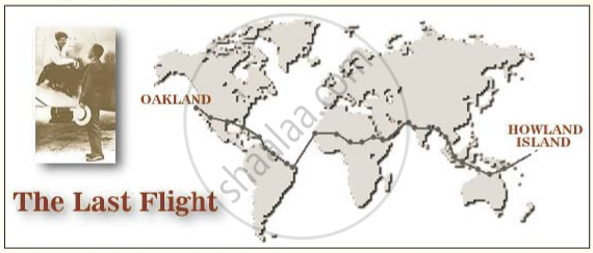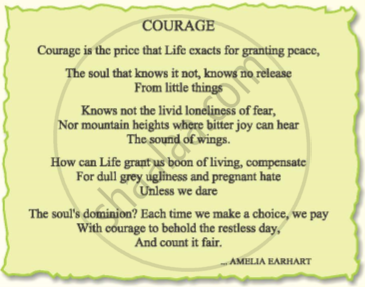Advertisements
Advertisements
प्रश्न
Study the following phrases and their meanings. Use them appropriately to complete the sentences that follow.
After a very long spell of heat, the weather is ………….. at last.
विकल्प
look after: take care of
look down on: disapprove or regard as inferior
look in (on someone): make a short visit
look into: investigate
look out: be careful
look up: improve
look up to: admire
उत्तर
After a very long spell of heat, the weather is look up at last.
APPEARS IN
संबंधित प्रश्न
Answer of these question in two or three paragraphs (100–150 words).
Why did Margie hate school? Why did she think the old kind of school must have been
fun?
Answer these question in 30–40 words.
Find at least two instances in the text which tell you that Bismillah Khan loves India and Benaras.
Expressions used to show fear
Can you find the expressions in the story that tell you that the author was frightened?
Read the story and complete the following sentences.
1. I was turned ______.
2. I sat there holding ______.
3. In the light of the lamp I sat there like ______.
Discuss in pair and answer question below in a short paragraph (30 − 40 words.
What “horrible idea” occurred to Jerome a little later?
Answer the following question in not more than 100 − 150 words.
Compare and contrast the atmosphere in and around the Baudhnath shrine with the
Pashupathinath temple.
Why does he break down in tears after the fire?
The world's most famous female aviator, Amelia Earhart, disappeared in 1937, as she attempted to become the first woman to fly around the world with her navigator, Fred Noonan. She was last heard when she was around 100 miles from the tiny Pacific Howland Island on July 2, 1937.
Read the story of her 'Final Flight'.
On June 1, 1937 Amelia and her navigator Fred Noonan departed from Miami, Florida; bound for California. Their first destination was San Juan, Puerto Rico; from there, skirting the northeast edge of South America; and then on to Africa and the Red Sea.
The flight to Karachi was another first. No one had previously flown non-stop from the Red Sea to India before. From Karachi, the Electra flew to Calcutta on June 17 from there on, to Rangoon, Bangkok, Singapore and Bandoeng.
The monsoon prevented departure from Bandoeng for several days. Repairs were made on some of the 'long distance' instruments which had given trouble previously. During this time, Amelia became ill, and suffered from dysentery that lasted several days.
It was June 27 before Amelia and Noonan were able to leave Bandoeng for Port Darwin, Australia. At Darwin, the direction finder was repaired, and the parachutes were packed and shipped home as they would be of no value over the Pacific .
Amelia reached Lae in New Guinea on June 29. At this point they had flown 22,000 miles and there were 7,000 more to go over the Pacific. Amelia cabled her last commissioned article to the Herald Tribune. Photos show her looking very tired and ill during her time at Lac.
The U.S. Coast Guard cutter, Itasca had been standing off Howland Island for some day to act as a radio contact for Amelia Radio communications in the area were very poor as Itasca was overwhelmed with commercial radio traffic that the flight had generated .

Amelie left Lae at preciaely 00:00 hours Greenwich Mean Time on July 2 . It is believed that the Electra was loaded with 1,000 gallons of fuel , allowing for 20-21 hours of flying .
At 07:20 hours GMT Amelia provided a position report placing the Electra on course as some 20 miles southwest of the Nukumanu Islands . The last weather report Amelia was known to have received was before take-off . The head wind speed had increased by 10-12 mph, but it is not known if she ever received the report.
At 08:00 GMT Amelia made her last radio contact with Lae . she reported being on course for Howland Island at 12,000 feet . There is no real evidence as to the precise track of the aircraft after Nukumanu . No one saw or heard the plane fly over .
Several short transmissions were received by the Itasca with varying signal strengths but they were unable to get a fix on her location because they were too brief. At 19:30 GMT the following transmission was received from the Electra at maximum strength.
"KHAQQ calling Itasca. We must be on you but cannot see you ... gas is running low ... "
At 20: 14 GMT, the Itasca received the last voice transmission from Amelia giving positioning data. The Itasca continued to transmit on all frequencies until 21:30 hours GMT. They determined that Amelia must have died at sea and began to implement search procedures.
It has been determined that the plane went down some 35-100 miles off the coast of Howland Island. A life raft was stowed on board but no trace was ever found of the raft. Some experts felt that the empty fuel tanks could keep the plane afloat for a period of time.
President Roosevelt authorized a search party of 9 naval ships and 66 aircrafts at an estimated cost of over $4 million. On July 18, the search was abandoned by ships in the Howland area. George continued to seek help in the search, but by October he too abandoned all hope of finding them alive.
Amelia had been sending letters to George at stopovers all along her route quite regularly. These were published in the book 'Last Flight'. The book has a note from her to George ....
"Please know I am quite aware of the hazards ... I want to do it because I want to do it. Women must try to do things as men have tried. If they fail, their failure must be, but a challenge to others. "

Amelia created a number of aviation records :
o The first woman to fly across the Atlantic in 1928
o The second person to fly solo across the Atlantic in 1932
o The first person to fly solo from Hawaii to California in 1935 Guided by her publicist and husband, George Putnam, she made headlines in an era when aviation had gripped the public's imagination.
A free bird leaps on the back
Of the wind and floats downstream
Till the current ends and dips his wing
In the orange suns rays
And dares to claim the sky.
Read the above lines and answer the question that follow.
Which birds are used to describe the state of the free bird?
The athletes had come from all over the country
To run for the gold, for the silver and bronze
Many weeks and months of training
All coming down to these games.
The spectators gathered around the old field
To cheer on all the young women and men
The final event of the day was approaching
Excitement grew high to begin.
Read the lines given above and answer the following question:
What do the words ‘gold’, ‘silver’ and ‘bronze’ stand for in the poem?
On getting Gopu Mama’s chappals, the music teacher tried not to look too happy. Why?
Who made the pact with the Sun and why? How did the pact prove fruitful?
The cat was very happy to be on the ground. Pick out the phrase used to express this idea.
Answer the following question. (Refer to that part of the text whose number is given against the question. This applies to the comprehension questions throughout the book.)
How did Patrick help him? (7)
Word in the box given below indicates a large number of… For example, ‘a herd of cows’ refers to many cows. Complete the following phrase with a suitable word from the box.
a _____________of chicks
Try to make a kite with your friends. Collect the things required such as colour paper/newspaper, thread, glue, a thin stick that can be bent. After making the kite see if you can fly it.
Answer the following question.
When Jumman’s aunt realised that she was not welcome in his house, what arrangement did she suggest?
Complete the following sentence by providing a reason:
Towards the end of the story B. Wordsworth, the poet told the boy to never visit him because ______.
|
Antonio: |
(Aside to Sebastian) Let it be tonight; |
What does Antonio refer to when he says “Let it be tonight...” in Act III, Scene iii of the play, The Tempest?
How does Lady Macbeth attempt to divert the attention of the guests from Macbeth’s strange behaviour at the banquet?
Complete the following sentence by providing a reason.
Beethoven amputated the legs of his piano because ______.
